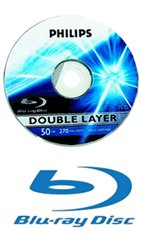Your New Hi-Definition Player will be Blu-Ray… Or will it?
 If you missed the latest round of format wars, consider yourself lucky. Similar to the competing formats of VHS -vs- Betamax, there was recent confusion over the hi-definition format that’s going to replace DVDs. The competing formats were Blu-Ray, and HD-DVD. Toshiba was the primary backer of HD-DVD, and recently conceded defeat in the high-definition DVD battle to Sony backed Blu-Ray.
If you missed the latest round of format wars, consider yourself lucky. Similar to the competing formats of VHS -vs- Betamax, there was recent confusion over the hi-definition format that’s going to replace DVDs. The competing formats were Blu-Ray, and HD-DVD. Toshiba was the primary backer of HD-DVD, and recently conceded defeat in the high-definition DVD battle to Sony backed Blu-Ray.
However, this time almost everyone who bought a player is a loser. People who purchased HD-DVD players will still be able to use them as up-converting DVD players, but HD-DVDs will soon be as hard to find as Betamax tapes. Many early adopters of Blu-Ray also have discovered they won’t be able to enjoy the new features of Blu-Ray’s 2.0 spec, as their players aren’t upgradeable. A notable exception is the PlayStation 3. In fact, if you’re in the market for a Blu-Ray player in the immediate future, the PS3 is easily the best bargain.
Does this mean it’s time for you to go out and buy a Blu-Ray hi-definition player? Probably not. DVDs are not going away for a long time, and the selection of titles on Blu-Ray is still very thin. New titles will continue to be released for DVD. You also won’t notice any difference unless you have a hi-definition television. Blu-Ray players are still very expensive, starting around $400. The disks cost more too. An average title that may cost $15 on DVD, may cost $25 on Blu-Ray. Blu-Ray players will probably be a hot item this Christmas, but won’t likely see widespread adoption until 2010.
While Blu-ray has won this battle, it may not win the hi-definition player war. High-speed Internet, improved compression algorithms, and increased flexibility of publishers make it look ever likely that consumers will be viewing their hi-definition content using an Internet connection, instead of a physical disk. Available now is the Apple TV, Hulu.com, Netflix Watch Instantly, and others. All offering on-demand, hi-definition content. While this content is not “true” hi-def, it’s very nice quality and is only sure to improve with time. IPTV (Internet Protocol TV) will also likely see widespread adoption in coming years.
Just as Netflix redefined home movie rental convenience, Internet delivery of high-quality content raises the bar of consumer expectations. I have Windows Vista running Media Center in my living room. Plugins like Anthony Park’s, allow you to select and watch Netflix movies from your couch with a remote, as easily as changing a channel.
Products like the Apple TV also promise a very seamless and integrated experience on your TV. Even the PlayStation 3 and Xbox360 offer similar hi-definition, instant viewing options. Instant movie rentals from home with either a monthly subscription, or per viewing charge has been promised for years. It’s available now, and will only grow in popularity.
Perceived improvement may be the last stumbling block. View a Blu-Ray disk, and an up-converted DVD disk on a high-def TV. The difference is not that great. Blu-Ray boasts more colors, and higher resolution, but it lacks the wow-factor that there was with VHS to DVD. It’s probably not enough for the average viewer to run out and pay $500 for a Blu-Ray player, or an extra $10 per disk.
Blu-Ray may have won the battle to earn your money with the purchases of Blu-Ray players and disks. Whether you will want or need to purchase them, is still to be decided.

